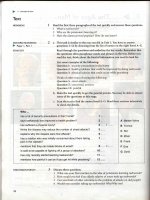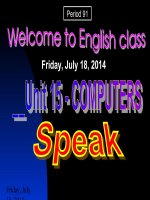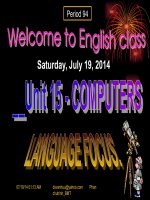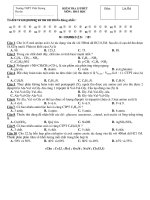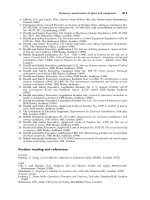E 114 15
Bạn đang xem bản rút gọn của tài liệu. Xem và tải ngay bản đầy đủ của tài liệu tại đây (90.96 KB, 5 trang )
Designation: E114 − 15
Standard Practice for
Ultrasonic Pulse-Echo Straight-Beam Contact Testing1
This standard is issued under the fixed designation E114; the number immediately following the designation indicates the year of
original adoption or, in the case of revision, the year of last revision. A number in parentheses indicates the year of last reapproval. A
superscript epsilon (´) indicates an editorial change since the last revision or reapproval.
This standard has been approved for use by agencies of the U.S. Department of Defense.
ANSI/ASNT CP-189 ASNT Standard for Qualification and
Certification of Nondestructive Testing Personnel
2.3 Other Documents:5
NAS-410 Certification and Qualification of Nondestructive
Test Personnel
2.4 ISO Standard:6
ISO 9712 Non-Destructive Testing—Qualificaiton and Certification of NDT Personnel
1. Scope*
2
1.1 This practice covers ultrasonic examination of materials by the pulse-echo method using straight-beam longitudinal
waves introduced by direct contact of the search unit with the
material being examined.
1.2 This practice shall be applicable to development of an
examination procedure agreed upon by the users of the
document.
3. Terminology
1.3 The values stated in inch-pound units are to be regarded
as standard. The values given in parentheses are mathematical
conversions to SI units that are provided for information only
and are not considered standard.
1.4 This standard does not purport to address all of the
safety concerns, if any, associated with its use. It is the
responsibility of the user of this standard to establish appropriate safety and health practices and determine the applicability of regulatory limitations prior to use.
3.1 Refer to Terminology E1316 for definitions of terms
used in this practice.
4. Basis of Application
4.1 Purchaser-Supplier Agreements: The following items
require agreement between the using parties for this practice to
be used effectively:
4.1.1 Qualification of Nondestructive Testing Agencies—
Agreement is required as to whether the nondestructive testing
agency, as defined in Specification E543 must be formally
evaluated and qualified to perform the examination. If such
evaluation and qualification is specified, a documented procedure such as Specification E543 shall be used as the basis for
evaluation.
4.1.2 Personnel Qualification—Nondestructive testing
(NDT) personnel shall be qualified in accordance with a
nationally recognized NDT personnel qualification practice or
standard such as ANSI/ASNT CP-189, SNT-TC-1A, NAS-410,
ISO 9712, or a similar document. The practice or standard used
and its applicable revision shall be specified in the contractual
agreement between the using parties.
4.1.3 Extent of Examination—The extent of the examination
shall be determined by agreement of the using parties.
4.1.4 Time of Examination—The time of examination shall
be determined by agreement of the using parties.
4.1.5 Interpretation Criteria—The criteria by which the
ultrasonic signals and part acceptability will be evaluated and
shall be determined by agreement of the using parties.
2. Referenced Documents
2.1 ASTM Standards:3
E317 Practice for Evaluating Performance Characteristics of
Ultrasonic Pulse-Echo Testing Instruments and Systems
without the Use of Electronic Measurement Instruments
E543 Specification for Agencies Performing Nondestructive
Testing
E1316 Terminology for Nondestructive Examinations
2.2 ASNT Standards:4
SNT-TC-1A Recommended Practice for Personnel Qualification and Certification in Nondestructive Testing
1
This practice is under the jurisdiction of ASTM Committee E07 on Nondestructive Testing and is the direct responsibility of Subcommittee E07.06 on
Ultrasonic Method.
Current edition approved Dec. 1, 2015. Published December 2015. Originally
approved in 1955. Last previous edition approved in 2010 as E114 - 10. DOI:
10.1520/E0114-15.
2
For ASME Boiler and Pressure Vessel Code applications see related Practice
SE-114 in Section II of that Code.
3
For referenced ASTM standards, visit the ASTM website, www.astm.org, or
contact ASTM Customer Service at For Annual Book of ASTM
Standards volume information, refer to the standard’s Document Summary page on
the ASTM website.
4
Available from American Society for Nondestructive Testing (ASNT), P.O. Box
28518, 1711 Arlingate Ln., Columbus, OH 43228-0518, .
5
Available from Aerospace Industries Association of America, Inc. (AIA), 1000
Wilson Blvd., Suite 1700, Arlington, VA 22209-3928, .
6
Available from International Organization for Standardization (ISO), ISO
Central Secretariat, BIBC II, Chemin de Blandonnet 8, CP 401, 1214 Vernier,
Geneva, Switzerland, .
*A Summary of Changes section appears at the end of this standard
Copyright © ASTM International, 100 Barr Harbor Drive, PO Box C700, West Conshohocken, PA 19428-2959. United States
1
E114 − 15
search unit and examination material must be maintained such
that the contact area is held constant while maintaining
adequate couplant thickness. Lack of couplant reducing the
effective contact area or excess couplant thickness will reduce
the amount of energy transferred between the search unit and
the examination piece. These couplant variations in turn result
in examination sensitivity variations.
6.1.3.1 The couplant should be selected so that its viscosity
is appropriate for the surface finish of the material to be
examined. The examination of rough surfaces generally requires a high-viscosity couplant. The temperature of the
material’s surface can change the couplant’s viscosity. As an
example, in the case of oil and greases, see Table 1.
6.1.3.2 At elevated temperatures as conditions warrant,
heat-resistant coupling materials such as silicone oils, gels, or
greases should be used. Further, intermittent contact of the
search unit with the surface or auxiliary cooling of the search
unit may be necessary to avoid temperature changes that affect
the ultrasonic wave characteristics of the search unit. At higher
temperatures, certain couplants based on inorganic salts or
thermoplastic organic materials, high-temperature delay
materials, and search units that are not damaged by high
temperatures may be required.
6.1.3.3 Where constant coupling over large areas is needed,
as in automated examination, or where severe changes in
surface roughness are found, other couplants such as liquid gap
coupling will usually provide a better examination. In this case,
the search unit does not contact the examination surface but is
separated by a distance of about 0.2 in. (5.1 mm) filled with
couplant. Liquid flowing through the search unit fills the gap.
The flowing liquid provides the coupling path and has the
additional advantage of cooling the search unit if the examination surface is hot.
6.1.3.4 An alternative means of direct contact coupling is
provided by the wheel search unit. The search unit is mounted
at the required angle to a stationary axle about which rotates a
liquid-filled flexible tire. A minimum amount of couplant
provides ultrasonic transmission into the examination surface
since the elastic tire material is in rolling contact and conforms
closely to the surface.
6.1.4 Reference Standards—The production item itself may
be an adequate standard using the height of the back wall echo
for reference. For more quantitative information, machined
artificial reflectors (discontinuities) or charts representing
distance-amplitude relationships of known reflector sizes for a
5. Significance and Use
5.1 This practice employs the use of normal-incident, or
straight beam, longitudinal wave ultrasound for the detection
and evaluation of discontinuities in materials requiring volumetric examination.
5.2 Although not all requirements of this practice can be
applied universally to all inspection situations and materials, it
does provide the basis for establishing contractual criteria
between suppliers and purchasers of materials for performing
contact longitudinal wave pulse-echo examination and may be
used as a guide for writing detailed procedures for particular
applications.
5.3 Types of information that may be obtained from the
pulsed-echo straight-beam practice are as follows:
5.3.1 Apparent discontinuity size (see Note 1) by comparison of the signal amplitudes from the test piece to the
amplitudes obtained from a reference standard.
5.3.2 Depth location of discontinuities by calibrating the
horizontal scale of the A-scan display.
5.3.3 Material properties as indicated by the relative sound
attenuation or velocity changes of compared items.
5.3.4 The extent of bond and unbond (or fusion and lack of
fusion) between two ultrasonic conducting materials if geometry and materials permit.
NOTE 1—The term “apparent” is emphasized since true size depends on
orientation, composition, and geometry of the discontinuity and equipment limitations.
6. Apparatus
6.1 Complete ultrasonic apparatus shall include the following:
6.1.1 Instrumentation—The ultrasonic instrument shall be
capable of generating, receiving, and amplifying highfrequency electrical pulses at such frequencies and energy
levels required to perform a meaningful examination and to
provide a suitable readout.
6.1.2 Search Units—The ultrasonic search units shall be
capable of transmitting and receiving ultrasound in the material
at the required frequencies and energy levels necessary for
discontinuity detection. Typical search unit sizes usually range
from 1⁄8 in. (3.2 mm) in diameter to 11⁄8 in. (28.6 mm) in
diameter with both smaller and larger sizes available for
specific applications. Search units may be fitted with special
shoes for appropriate applications. Special search units encompassing both a transmitter and a receiver as separate piezoelectric elements can be utilized to provide some degree of
improved resolution near the examination surface.
6.1.3 Couplant—A couplant, usually a liquid or semi-liquid,
is required between the face of the search unit and the
examination surface to permit or improve the transmittance of
ultrasound from the search unit into the material under test.
Typical couplants include water, cellulose gel, oil, and grease.
Corrosion inhibitors or wetting agents or both may be used.
Couplants must be selected that are not detrimental to the
product or the process. The couplant used in standardization
should be used for the examination. During the performance of
a contact ultrasonic examination, the couplant layer between
TABLE 1 Suggested Viscosities—Oil Couplants
NOTE 1—The table is a guide only and is not meant to exclude the use
of a particular couplant that is found to work satisfactorily on a particular
surface.
2
Approximate Surface Roughness Average
(Ra), µin. (µm)
Equivalent Couplant
Viscosity, Weight Motor
Oil
5–100 (0.1–2.5)
50–200 (1.3–5.1)
100–400 (2.5–10.2)
250–700 (6.4–17.8)
Over 700 (18–)
SAE 10
SAE 20
SAE 30
SAE 40
cup grease
E114 − 15
7.6 For bond/unbond (fusion/lack of fusion) examinations, a
reference standard should be used similar to the production
item being examined containing areas representing both
bonded (fused) and unbonded (lack of fusion) conditions, if
geometry and material permit.
particular search unit and material may be used for standardization. These artificial reflectors may be in the form of
flat-bottom holes, side-drilled holes, or slots. An alternate
method of fabricating a reference standard may be the introduction of known discontinuities during the fabrication process
of a production item or other convenient configuration. The
surface finish of the reference standard should be similar to the
surface finish of the production item (or corrected; see 7.3).
The reference standard material and the production material
should be acoustically similar (in velocity and attenuation).
The reference standard selected shall be used by the examiner
as the basis for signal comparisons.
7.7 Standardization with respect to reference standards
should be periodically checked to ensure that the ultrasonic
system standardization is not changing. As a minimum, the
standardization shall be checked each time there is a change of
operators, when search units are changed, when new batteries
are installed, when equipment operating from one power
source is changed to another power source, or when improper
operation is suspected.
7. Standardization of Apparatus
7.1 If quantitative information is to be obtained, vertical or
horizontal linearity or both should be checked in accordance
with Practice E317 or another procedure approved by the users
of the document. An acceptable linearity performance may be
agreed upon by the users of the document.
8. Procedure
8.1 When ultrasonic examinations are performed for the
detection or sizing of discontinuities, or both, reflectors not
perpendicular to the ultrasonic beam may be detected at
reduced amplitudes, with a distorted envelope depending upon
the reflector area, whether it is curved or planar, whether it is
smooth or rough, perhaps with reflecting facets. Reflector
characteristics may also cause rapid shifts in apparent depth as
the search unit approaches or moves away from the low
amplitude indication. Another effect of these reflectors is the
loss of back reflection which occurs when the discontinuity lies
directly between the search unit and the back surface. Reflectors detectable due to any of the foregoing phenomena cannot
be sized solely on signal amplitude but require special corrections for search unit and flaw characteristics.
7.2 Prior to examination, standardize the system in accordance with the product specification.
7.3 Where the surface finishes of the reference standard and
the production item do not match, or where there is an acoustic
difference between the standard and the production item, an
attenuation correction should be made to compensate for the
difference. The attenuation correction is accomplished by
noting the difference between signals received from the same
reference reflector (that is, back reflection) in the basic standardization (reference) block and in the production material,
and correcting for this difference.
7.4 It should be recognized that near-field effects may cause
sensitivity inconsistencies when searching for discontinuities
smaller than the effective beam diameter. Suitable delay line
search units or other means such as examining from both sides
of the item may be considered where the application warrants
fine scrutiny. When performing examinations in the far-field, it
is recommended that compensation be made for the acoustic
attenuation of the test material with respect to a certain
reference standard. This compensation may be accomplished
with multiple depth reference reflectors, electronically, with
attenuation curves drawn on the face of the A-scan display, or
with charts for distance-amplitude relationships of known
reflectors. For optimum examination performance, compensations should be made for both near and far-field effects.
8.2 Examination Surface—Surfaces shall be uniform and
free of loose scale and paint, discontinuities such as pits or
gouges, weld spatter, dirt, or other foreign matter which affect
examination results. Tightly adhering paint, scale, or coatings
do not necessarily need to be removed for examining if they
present uniform attenuation characteristics. The examination
surface must be adequate to permit ultrasonic examination at
the sensitivity specified. If needed, surfaces may be ground,
sanded, wire brushed, scraped, or otherwise prepared for
examining purposes. Curved surfaces, either concave or
convex, may be examined; however, the standardization system should compensate for the effective change in search unit
transmitting area between the reference standard and production item. If practical, the reference standard should have the
same geometry as the item being examined.
7.5 Unless otherwise specified, the initial pulse and at least
one back reflection shall appear on the A-scan display while
examining for discontinuities in materials having parallel
surfaces. The total number of back reflections depends upon
equipment, geometry and material type, information desired, or
operator preference. Reduction of the back reflection during
scanning is indicative of increased attenuation or sound scattering discontinuities provided that front and back surface
roughness and parallelism of the production piece are approximately the same as that of the standard. For non-parallel
surfaces, the time trace of the display shall be standardized by
using standards that include the maximum thickness of the
production item being examined.
8.3 Search Unit—Select a suitable search unit size and
frequency after consideration of the acoustic characteristics of
material to be examined, the geometry of the production item,
and the minimum size and type of discontinuity to be detected.
The higher the frequency selected, the higher the resolving
capability accompanied with a decrease in penetrating power;
conversely, the lower the frequency used, the greater the
penetrating power with decreasing resolving capability. Factors
limiting the use of higher frequencies are the equipment and
the material properties. The limiting use of lower frequencies is
the loss in sensitivity level for the examination and increasing
beam spread. Various types of straight-beam search units are
available offering advantages for specific applications. The
3
E114 − 15
eration should be given to discontinuities when the signal
amplitude drops to half the maximum amplitude or less, and
remains at the lower level over extended distances (for
example, more than half the search unit diameter).
above statements should be considered when choosing the
search unit size, type, and frequency. When delay materials are
used in the search unit, the standardization and examination
surface temperatures should be within 25°F (14°C) to avoid
large attenuation and velocity differences.
NOTE 3—For rounded surfaces, geometry must be considered when
using this method.
NOTE 2—The largest diameter and highest frequency search units
yielding desired results should be used for maximum resolution and good
beam directivity.
9. Examination Data Record
9.1 The following data should be recorded as a minimum
for future reference at the time of each examination:
9.1.1 Part number identification,
9.1.2 Operator’s name and level (if certified),
9.1.3 Instrument description, make, model, and serial
number,
9.1.4 Setup—Couplant, cable type and length, manual/
automatic scanning,
9.1.5 Search unit description—Type, size, frequency, special shoes,
9.1.6 Reference standards (and standardization data required to duplicate the examination).
9.1.7 Indication information as specified by the applicable
specification, or results of the examination (number,
classification, and location of discontinuities). For bond/
unbond (fusion/lack of fusion) examinations the extent of
unbond (lack of fusion) or bond (fusion) should be reported.
8.4 Scanning—Scanning may be either continuous or
intermittent, depending upon the geometry, application, and
requirements of the part being examined. For continuous
scanning, the search unit indexing must be adequate to provide
100 % coverage, at uniform examination sensitivity, of the area
being examined. Adjust scanning speed or instrument repetition rate or both to permit detection of the smallest discontinuities referenced in the specification and to allow the recording or signaling device to function. For manual scanning using
no recording or alarming device, a maximum scanning speed
of 6 in. (15 cm) per second is recommended.
8.4.1 Manual Scanning—Hold the search unit in the hand
and move over the surface of the production piece.
8.4.2 Automated Scanning—The search unit is held by a
suitable fixed device and either the production piece moves or
is held stationary while the search unit moves mechanically
along some predetermined path. For automated scanning,
monitor coupling between the search unit and part either
electronically or visually to ensure proper examination sensitivity.
10. Interpretation of Results
10.1 Advance agreement should be reached by users of this
document as applicable regarding the interpretation of the
results of the examinations and how they shall be recorded. All
discontinuities having signals that exceed the rejection level as
defined by the material specification, drawing, or purchase
order shall be rejected unless it is determined from the machine
part drawing that the rejectable discontinuities will not remain
in the finished part.
8.5 During the evaluation of indications, maintain the same
relative sensitivities between the reference standard and the
production item. Make an evaluation of ultrasonic indications
after response reflections from discontinuities are maximized
by search unit manipulation. Map discontinuity extremities
larger than the sound beam. A recommended method for
mapping, on the surface of the production piece, the apparent
size (that is, the reflecting surface seen by the search unit) of
discontinuities larger than the search unit is by the halfamplitude method. Position the search unit over the discontinuity for maximum signal response and move in one direction
until the signal drops rapidly to the base line on the A-scan
display. Then return the search unit to the position where the
signal was half the amplitude that it had at the point where the
indication began to drop rapidly to the base line. At this point
the center of the search unit should approximately coincide
with the edge of the discontinuity. Repeat this procedure for
other directions as necessary to outline the discontinuity on the
surface. Search units of other frequencies and sizes may be
used for mapping to obtain greater accuracy. Special consid-
11. Report
11.1 The report resulting from the examination should
document the pertinent information relative to the application.
While each inspection may require different information and
levels of detail, at a minimum, the report should include:
11.1.1 Date and time of examination,
11.1.2 The examination data record, and
11.1.3 Pass/fail examination result.
12. Keywords
12.1 contact; examination; nondestructive testing; pulseecho; straight-beam; ultrasonic
4
E114 − 15
SUMMARY OF CHANGES
Committee E07 has identified the location of selected changes to this standard since the last issue (E114 - 10)
that may impact the use of this standard.
(1) Added ISO 9712 to 2.4 and 4.1.2.
(2) Modified Section 11 to provide some minimum report
requirements.
ASTM International takes no position respecting the validity of any patent rights asserted in connection with any item mentioned
in this standard. Users of this standard are expressly advised that determination of the validity of any such patent rights, and the risk
of infringement of such rights, are entirely their own responsibility.
This standard is subject to revision at any time by the responsible technical committee and must be reviewed every five years and
if not revised, either reapproved or withdrawn. Your comments are invited either for revision of this standard or for additional standards
and should be addressed to ASTM International Headquarters. Your comments will receive careful consideration at a meeting of the
responsible technical committee, which you may attend. If you feel that your comments have not received a fair hearing you should
make your views known to the ASTM Committee on Standards, at the address shown below.
This standard is copyrighted by ASTM International, 100 Barr Harbor Drive, PO Box C700, West Conshohocken, PA 19428-2959,
United States. Individual reprints (single or multiple copies) of this standard may be obtained by contacting ASTM at the above
address or at 610-832-9585 (phone), 610-832-9555 (fax), or (e-mail); or through the ASTM website
(www.astm.org). Permission rights to photocopy the standard may also be secured from the Copyright Clearance Center, 222
Rosewood Drive, Danvers, MA 01923, Tel: (978) 646-2600; />
5

